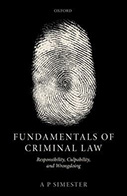Fundamentals of Criminal Law

Author: Andrew Simester
Publisher: Oxford University Press, 2021. 544 pages.
Reviewer: Penny Crofts | December 2022
Professor Andrew Simester is the Edmund-Davies Chair in Criminal Law at King’s College London and Amaladass Professor Criminal Justice at the National University of Singapore. Simester has been a major thinker in criminal law for decades and is beloved by students for his clear and accessible criminal law textbooks.
Fundamentals of Criminal Law is definitely written for the unashamed criminal law geeks, myself included. It is an in-depth reading and analysis of criminal legal doctrine. In keeping with his interest in theory, Simester seeks to explore the philosophical underpinnings of the criminal legal categories of actus reus, mens rea, and defenses. To a certain extent, the book thus follows a classic structure of criminal law. However, Simester adds nuance to this analysis by pointing to prior questions (such as moral agency) and links between the different categories—e.g., between causation and mens rea.
Simester demonstrates an encyclopaedic knowledge of Anglophone cases and doctrine, analysing classic cases in terms of theory and doctrine. He refuses to accept judicial justifications at face value, and instead interrogates judgment and doctrine for the kinds of principles that they are expressing, as well as those that he thinks they should express. This critical approach is productive and offers alternative readings of classic cases and legal doctrine. For example, Simester considers the classic case of Blaue [1975] 3 All ER 466, in which V, a Jehovah’s Witness who was stabbed four times by B, is brought to the hospital and refuses a blood transfusion that would save her life. V then dies of blood loss the next day. B claims that the refusal by the victim of a blood transfusion was a novus actus interveniens that broke the causal chain between the stabbing and V’s death. Simester notes that the Court of Appeal was correct in holding that the wounds inflicted by B were the operating cause of death. However, he asserts that the Court of Appeal went too far in stating:
It has long been the policy of the law that those who use violence on other people must take their victims as they find them. This in our judgment means the whole man, not just the physical man. It does not lie in the mouth of the assailant to say that his victim’s religious beliefs which inhibited him from accepting certain kinds of treatment were unreasonable (p. 450).
This is a quote that students are often taught from Blaue. But Simester asserts that this is a misreading of the principles of causation, asserting:
The truth of the matter is that Blaue did not turn at all on whether V’s refusal of the transfusion was ‘daft’ or foreseeable, because the failure to transfuse blood was an omission. As such, the case presented a straightforward, unbroken physical chain from stabbing to death. We may wish that the causal chain had been severed. But an omission cannot, by itself, do that. The failure to transfuse, however unreasonable, could only be a concurrent case of death (p. 128).
This is an example of the kind of focused, thought provoking, and nuanced reading that Simester offers throughout Fundamentals of Criminal Law.
I particularly enjoyed Simester’s turn to theory to think through the philosophical underpinnings of classic legal doctrine. Simester provides an accessible and generous reading of legal theory about criminal legal doctrine, carefully explaining why he agrees or disagrees with arguments. He then supplements this reading by turning to general philosophy. He commences Fundamentals of Criminal Law by arguing that criminal law has multiple functions, including prevention, inquiry, and punishment. But he argues that a core function of criminal law is bound up with moral censure—i.e., “whether in preventive or punitive mode, the criminal law speaks with a moral voice” (p. 4). He argues that the label of criminality, that is, that the accused is ‘guilty’ has a resonance that is different from civil law. He sustains this moral focus throughout the book. For example, in Chapter Four, he articulates principles of “moral responsibility,” stating that this “designates an agent’s eligibility for evaluations of moral praise or blameworthiness” (p. 77). He argues that D has to be morally responsible before questions of whether D is praise- or blameworthy can be considered. Simester correctly asserts that moral responsibility is a threshold condition, which D may fail for physical reasons (such as paralysis) or mental reasons (such as suffering insane delusions).
Fundamentals of Criminal Law does, however, fail to engage with corporate criminal liability, in line with many other analyses of classic criminal legal doctrinal. Simester does make a few short points about corporations as moral and criminal agents, but these are afterthoughts. Given the increasing recognition and knowledge of harms caused by corporations and the sustained difficulties and failures of the criminal law to conceptualise corporations as criminal legal subjects, I think that this is a shame and a lost opportunity. It would have been great to turn Simester’s exhaustive and concentrated knowledge of criminal legal doctrine and philosophy to the question of corporate culpability and to perhaps challenge extant doctrine from a more radical perspective.
Penny Crofts, Professor, Faculty of Law, University of Technology Sydney.


